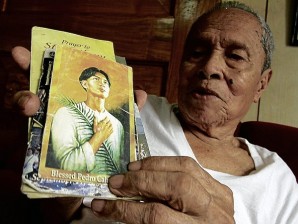
JAIME Calungsod, 85, shows the prayer booklets on Blessed Pedro Calungsod, whom he claims is his distant relative. TONEE DESPOJO, Cebu Daily News
GINATILAN, Philippines – Nowhere in the country will Catholics celebrate the canonization of Blessed Pedro Calungsod with deeper passion than in this poor agricultural town on the Tanon Strait.
For four days starting Thursday (October 18), Ginatilan, a fifth-class municipality (annual income: P10 million-P20 million) 135 kilometers southwest of Cebu City, will hold processions, novenas and Masses to boost its claim of being the hometown of Calungsod despite the absence of historical proof.
The residents of the town are mostly farmers and fishers. The population is 15,327, including the Calungsod families who are mostly living in Barangay (village) Cagsing.
Calungsod, along with Fr. Diego de San Vitores, was killed with a cutlass by two villagers in Guam on April 2, 1672, for catechizing and baptizing the natives.
Consolacion Calumpang, 81, could not believe that she would see the day that a native of her own town would become the first Visayan saint. She has been praying for good health to Blessed Pedro since he was beatified in 2000.
“Calungsod is the saint of our generation, and we are privileged to be able to take part in the celebration,” said Bebe Casinto, a resident of Barangay San Roque. “It is not every day that we get to have a saint. We have to make the occasion the best for him.”
Casinto heads the construction of nipa huts in all of the town’s 14 barangay (villages), where residents will share lunch, “barrio fiesta” style, after a 10 a.m. Mass at the St. Gregory the Great Parish Church on Sunday, the day of Blessed Pedro’s canonization in Rome.
The surroundings of the church have been improved for the occasion. On the side of the church adorned with buntings now stands a statue of Blessed Pedro where devotees say novenas.
Posters showing an image of Blessed Pedro have gone up on both sides of the streets. Beach and mountain resorts, and other businesses have sprouted in time for the canonization.
Although there are no existing records to show that Calungsod was one of its sons, Ginatilan steadfastly claims that he was one of its own. To further strengthen the claim, the municipal council has formed a team led by its secretary, Glynna Jumoad, to trace the family tree of Calungsod.
Baptismal records in the municipality show that the earliest birth of a Calungsod was that of Victoria Francisca Calungsod, who was baptized in 1850, and the earliest death was that of Luciano Calungsod, 37, in 1852.
Jumoad said she believed that a lot of Calungsods were born before the 1700s, but the records have been scanty. The team has also traced a Catalina Calungsod who was born in 1778, a date calculated back from her death in 1858 at the age of 80.
According to Jumoad, the oldest Calungsod alive could be Urbana Calungsod Gonser-Mayorita, 93, who was born on July 20, 1919, and is now living in Sitio Danao, Boljoon town. Her grandparents, who came from Ginatilan, migrated to Boljoon in search of land to till.
“She is still strong and she still works in the farms. We are going back to their place any time soon to personally invite her and her family to attend our celebration,” Jumoad said.
Images of Blessed Pedro are being sold at P80 to P150 each, depending on size, although these were not exactly what the Archdiocese of Cebu approved. Prayer booklets go for P15 each and T-shirts bearing Calungsod’s image cost P250 each.
Several resorts are already fully booked for three nights, with tourists and other visitors coming from Cebu City and other neighboring provinces to join the celebration.